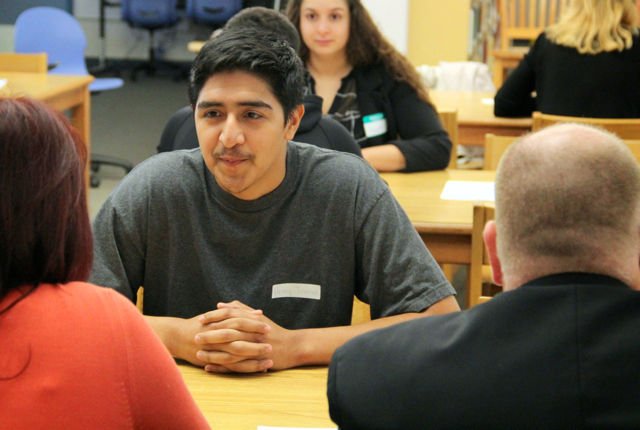South Valley women and children learn how to defend themselves
with both words and actions
“Kick me! I’m a black belt, I can take it – kick me right here,” yells Marieta De La Cruz, a third degree black belt who is teaching a self-defense class for children at Morgan Hill Community Center. “I’m a big bully and I’m about to get you, so kick me!”
As De La Cruz walks down the line, pretending to reach out and grab each student, the elementary school-aged kids take turns blocking her arms and landing a practice kick to her midsection. She corrects them or congratulates them as she goes.
Another group of kids have paired up. One child goes on the attack and the other deflects with a quick punch and a series of moves that temporarily immobilize their attacker so they can get away. A third group practices their foot placement for kicks.
“Marieta’s wonderful. She focuses on the kids’ confidence and really emphasizes when it’s OK to defend themselves and when it’s not OK,” said Dianne Slykas, a Hollister resident whose 8-year-old son, Steven Sausedo, is enrolled in the class. “We had Steven in a different class in Hollister, and it didn’t work for him. Since he’s been taking this class, we’ve seen his self-esteem improve, and I know he’s learning how to handle bully situations.”
The kids are learning techniques from the martial art Chinese Kempo, explained Arceli Bell, a first degree black belt who assists De La Cruz during class.
“We always emphasis that this is strictly for self-defense only, and they can’t go around using these techniques incorrectly,” Bell said. “We teach them verbal and physical defense. We say, ‘What would you say if a bully does this? What would you do? How can you get out of the situation?’ We teach them to go and get an adult to help them. If there’s no one around to help them and a bully is trying to hurt them, then and only then can you use physical force.”
The same is true for adult self-defense, said Debbie Ruiz, a safety and support services case manager for Community Solutions who teaches self-defense classes all over the South Valley. One of the main focuses of class is to teach women to recognize when they’re uncomfortable in a situation and to get out before it turns dangerous.
“Even if the situation turns into something where a woman has to use self-defense techniques, the techniques are quick moves designed to help the woman get away. They’re not about standing there and fighting and taking down some huge guy,” Ruiz said. “The moves are simple and easy, and they’re not about strength. It’s about using what’s available to you to help you defend yourself and to get out of the situation.”
When teaching self-defense classes at senior citizen centers, Ruiz said, she makes sure to explain that even if someone uses a cane or wheelchair, they still have the ability to defend themselves.
“If you use a cane, you can use it as a weapon,” she said. “If you’re in a wheelchair, you still have your arms and you can use them to defend yourself. We learn to use our strengths against their weaknesses.”
Ruiz uses a life-sized dummy during classes to show women how to use these weaknesses to their advantage.
“See here? This guy has a six pack. If I hit him there, it’s not going to do anything,” she said, pointing at the dummy’s abdomen. “And if I hit him above his eye, I’m just going to make him mad. But if I hit him in the nose, chances are he’s going to tear up and grab his nose. That means he’s let go of you and you can get away.”
If an attacker grabs a woman by the wrist, she can use the weak point where his forefinger and thumb meet to pull her hand away, Ruiz said, and is quick to reiterate that any technique a woman can use standing up, she can also use laying down.
To be certified to teach self defense classes, Ruiz had extensive training in Los Angeles. The training involved having men grab her and forcefully hold her so she could see what it felt like.
“A lot of it is in your head. When a guy grabbed me for the first time, I froze,” Ruiz said. “I had to remember to take a deep breath and turn that fear into anger and then use that anger to help me act. When someone’s choking you, it’s hard to stay calm. Self-defense classes are just one tool you can have to help you. You can remember, ‘OK, I know what to do here.’ And hopefully, the classes can help keep you from getting into that situation in the first place.”
The first steps to practicing self-defense, Ruiz said, is to walk tall and with confidence. Make eye contact with people and be aware of your surroundings. Know where exits are, park under light posts at night and try to walk with groups of people.
“Look at the statistics – last year our crisis line got more than 500 calls,” Ruiz said. “Clearly, women need to be empowered and self defense classes are a great way to do that.”
Want to assist teaching classes?
– Community Solutions will begin a six-week volunteer training Sept. 12. Volunteers will act as advocates for domestic violence and sexual assault victims, as well as assist in self-defense training. For more information, contact Amy Molica
at (408) 846-4751.
Want to take a self- defense class?
– For women’s and children’s
self-defense seminars, call Debbie Ruiz of Community Solutions at (831) 637-1094 or (408)
846-4795. Classes in English and Spanish. Classes are $50-$100 as a suggested donation. However, no one will be turned away.
– For women’s and children’s
self-defense through Chinese Kempo at the Morgan Hill
Community Center, call Marieta De La Cruz at (408) 607-4313. Classes are $35-$60.
– Gavilan College offers
self-defense classes for women and martial arts classes. For
more information, call
(408) 848-4800 or visit www.gavilan.edu. Classes begin Sept. 5 and cost $26 per unit.












